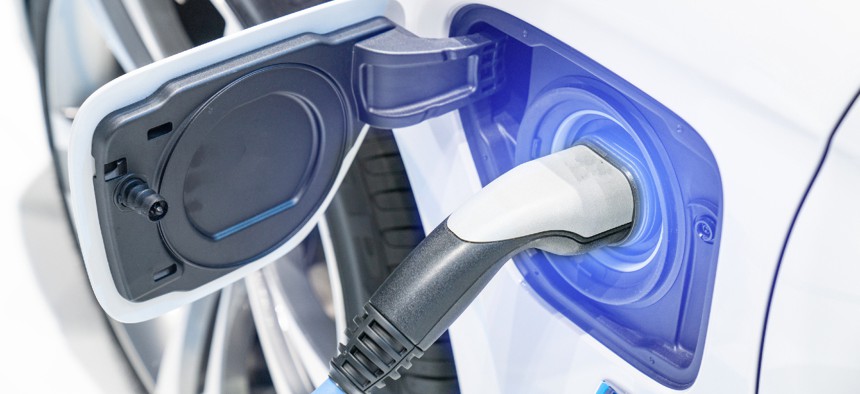
Federal officials drive an average of 6,000 miles per year in government vehicles, according to the Government Accountability Office. Witthaya Prasongsin/Getty Images
Federal Agencies Have a Lot of Work to Do to Meet Biden's Goal for Full Fleet Electrification
Only a small fraction of federally owned vehicles are currently electric.
The federal government is well positioned to adapt to an electrification of its 610,000-vehicle fleet, according to a new report, though it has a lot of work ahead of it to make that plan realistic.
President Biden late last year issued an executive order instructing agencies to stop purchasing non-tactical gas-powered vehicles altogether by 2035 and to purchase only zero-emission sedans, SUVs and pickup trucks by 2027. The order excluded the U.S. Postal Service fleet, meaning it will impact about 380,000 vehicles. To date, the Government Accountability Office found in a report issued Thursday, agencies own only 1,579 zero-emission vehicles, or less than 1% of the government’s fleet.
The government replaces about 8% of its fleet per year, GAO said, citing data from the General Services Administration, which owns and operates the federal fleet. It will have to increase its EV purchases by about 30,000 per year to meet Biden’s goal, GAO estimated. That will mark a dramatic shift from current trends: in 2021, agencies replaced about 12% of their vehicles, or about 33,000 sedans, pickup trucks and SUVs. Just 257 of those were zero emissions vehicles.
The government currently only has 4,000 charging ports at 1,000 locations within federal property. It will eventually have to increase that by orders of magnitude, with GAO estimating it will need to acquire 100,000 ports to meet Biden’s goal. Most of the stations agencies currently have are level two, which allow users to fully charge a vehicle overnight, but GAO suggested they will need to purchase some “fast chargers” that allow for vehicles to reach their full capacity within an hour.
“Electrifying federal fleets represents a significant transformation in the federal government’s approach to vehicle procurement and will require a shift in perceptions about their capability to adequately meet mission needs in terms of performance and driving range,” GAO said.
In response to the report, GSA Administrator Robin Carnahan said his agency is up to the task, suggesting his agency will soon become a “one-stop shop” to meet agencies’ fleet electrification needs. It already had 63 zero-emission vehicles as part of its offerings to agencies and earlier this year set up a blanket purchase agreement that includes more than 1,000 charging products. GSA is also working on issuing an indefinite quantity contract for charging station construction.
GSA does not issue mandates on which or how many vehicles agencies must lease or purchase, leaving that up to each individual federal office to determine. GAO said, however, that federal agencies are well-suited to meet Biden’s vision.
“Given the types of vehicles that federal fleets operate and how they are used, agencies have the potential to increase their acquisitions of zero-emission vehicles,” GAO wrote.
Federal officials drive an average of 6,000 miles per year in government vehicles, GAO found. In rural areas, the average was 7,500 miles per year, though 70% of government vehicles are located in urban areas. Those figures represented relatively low usage rates, GAO said, that were well within the recommended boundaries for EV use. Based on its analysis of fleet data, GAO found “no indications that a significant portion of federal fleets would regularly exceed” the limits of what GSA recommends for zero-emission vehicles.
As part of Biden’s order, agencies will have to submit annual targets, including plans for electric vehicle charging stations, elimination of unnecessary vehicles and conversion of polluting to emission-free vehicles. The governmentwide effort will also have its own working group to oversee progress.
The U.S. Postal Service, which maintains its own fleet separate from GSA of more than 200,000 vehicles, is currently in the process of replacing most of its vans and trucks. After significant disagreement and criticism from the White House and others, postal management eventually agreed to purchase half of its initial order as EVs. Congress subsequently provided $3 billion to USPS to purchase even more EVs and charging stations. The mailing agency has not yet updated its plan to account for the cash infusion.







